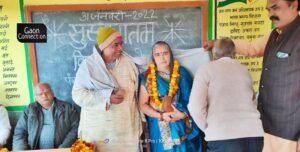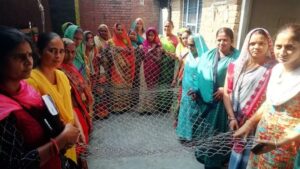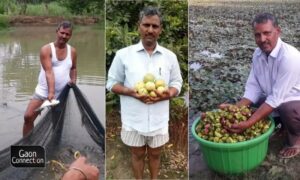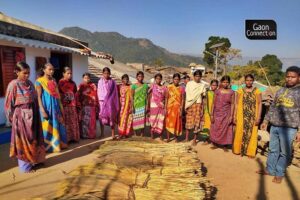Sitting in the courtyard of her pucca house, in Venkatraipur, a coastal village in Ganjam district of Odisha, about 165 kms away from Bhubaneswar, the state capital, M Savitri shudders at the memory of the 1999 super cyclone that killed about 10,000 people in the state. “The cyclone took away our home with it. Our entire village was inundated. We had nothing to eat. This house that you see is a new one,” the 58-year-old told Gaon Connection.
But two decades later, there is a sense of confidence amongst the residents of Venkatraipur, and those of Noliasahi, 270 kilometers away, in Jagatsingphur district, as they have been certified ‘Tsunami-Ready’ by the UNESCO last month.
These two tiny coastal villages in Odisha are the first to receive this certification among 22 Indian Ocean member states (countries). The communities in Venkatraipur and Noliasahi are now certified for both disaster-preparedness and disaster response. And this is important because Odisha’s coastline is battered by calamitous cyclones year after year.
The Tsunami-Ready programme was devised by the Intergovernmental Oceanographic Commission of UNESCO to develop and implement the Indian Ocean Tsunami Warning and Mitigation System. It trains coastal communities in disaster-preparedness in order to minimise loss of life and property and works with various stakeholders such as the inhabitants of the tsunami-vulnerable villages, community leaders and national and local management agencies.
“Venkatraipur and Noliasahi achieved the distinction of becoming first in the Indian Ocean region to become Tsunami-Ready, and we hope this recognition by UNESCO-IOC will catalyse wider implementation in other communities in India and the wider Indian Ocean region,” said Srinivasa Kumar Tummala, head of the Indian Ocean Tsunami Warning and Mitigation System.
“Our community would like to thank UNESCO-IOC for this recognition, and for enhancing the sustainability of our community against tsunami hazard,” added Appa Rao, community leader at Venkatraipur village.

Disasters revisited
The super cyclone that swept away Savitri’s home was perhaps one of the worst ever to hit Odisha in more than a 100 years. “In the recorded history of cyclones for the State of Orissa, the Super Cyclone of 29-30 October, 1999 was undoubtedly the most intense one,” wrote S R Kalsi of India Meteorological Department (IMD) in his report on the disaster.
Venkatraipur and Noliasahi bore the brunt of the cyclone fury. “All my boats were blown away by the winds,” recalled L Rammurthy, a 37-year-old fisherman from Venkatraipur village. “I couldn’t go fishing for months until I was able to mend my fishing nets and get new boats. I had to turn to moneylenders in order to feed my family,”
At Noliasahi, where the cyclone made its landfall, there was mayhem. The IMD reported more than 7,000 deaths in 209 villages of Ersama block. “Noliasahi village was almost totally submerged, over 200 people died, and those who survived fled to a nearby hilltop. We didn’t have shelter buildings,” Bhimasen Rout, sarpanch, Noliasahi village, Gadaharishpur gram panchayat, Ersama block, told Gaon Connection.
That year, 14 districts of Odisha covering 120 blocks were decimated by the cyclone. At least 1.9 million houses were damaged. Heavy rains and floods cut off the state from the rest of the country. More than 10,000 people died.

After the cyclone, the Odisha government implemented several policy measures, built cyclone and flood shelters and set up the autonomous Odisha State Disaster Mitigation Authority, which was later renamed as Odisha State Disaster Management Authority in 2008. It also put into place systems to mitigate the impact of such cyclones. Evacuation routes were planned and coastal embankments were strengthened. Besides these, mock drills were conducted each year in the state’s coastal belt.
“It was of utmost urgency to prioritise disaster training,” Kailash Chandra Behara, block development officer of Ersama, told Gaon Connection.
While Odisha’s state agencies were working on disaster preparedness and disaster response, within five years of the 1999 super cyclone, a tsunami hit the Indian Ocean in December 2004. It caused unprecedented damages and losses. It swept away 230,000 lives and displaced over 1.6 million people, with estimated economic losses of US$14 billion.
In its aftermath, the United Nations General Assembly mandated The Intergovernmental Oceanographic Commission of UNESCO to form an Intergovernmental Coordination Group for the Indian Ocean Tsunami Warning and Mitigation System. This was established in June 2005. It took UNESCO-IOC, Australia, India and Indonesia another eight years of hard work before the tsunami warning and mitigation system was declared fully operational in 2013.

To weather the storm
The Indian Ocean Tsunami Ready programme was kickstarted in September 2017 at a workshop in Jakarta, Indonesia, by the Intergovernmental Coordination Group and the Indian Ocean Tsunami Warning and Mitigation System, along with the Indian Ocean Tsunami Information Centre. It was modeled on a similar programme that was implemented in the United States and the Caribbean in 2015. Guidelines were finalised, which included indicators, checklists and a plan for pilot implementation and national recognition of Tsunami Ready communities.
In India, to implement the tsunami-ready programme, a National Board was formed. Its chairperson was the director, Indian National Centre for Ocean Information Centre. Other members were from the Union Ministry of Earth Sciences, National Disaster Management Authority, Ministry of Home Affairs, Odisha State Disaster Management Authority, and Andaman & Nicobar Islands Directorate of Disaster Management.
As part of the programme, in 2018, over 119,000 people across 10 countries in the Indian Ocean Region took part in tsunami mock exercises, called IOWave18 that tested their tsunami readiness indicators. This would enable the communities to apply for certification.
Six coastal communities from Odisha – Jayadevkasaba Pahi (Balasore district), Podhuan (Bhadrak district), Tantiapal Sasan (Kendrapara district), Keutajanga (Puri district) and the villages of Noliasahi (Jagatsinghpur district), and Venkatraipur (Ganjam district) along with one community in Oman (AlSawadi Alsahil), took part in the exercise.

“The programme allowed us to test the tsunami-readiness of the community,” Bholanath Mishra, General Manager (Geo-Technology), Odisha State Disaster Management Authority, who led the Tsunami-Ready mission in Odisha, said to Gaon Connection. “The cyclone-prone coastal villages have already been training in disaster preparedness since 1999, and now we have stepped up our operations through more training sessions, capacity building, and distribution of outreach material,” he explained.
How Noliasahi and Venkatraipur became tsunami-ready
In order for the communities to get the Tsunami-Ready tag, eleven parameters had to be adhered to. They were, conducting community tsunami-risk reduction programs, designation and mapping of tsunami hazard zones, public display of tsunami information, easily understood tsunami evacuation maps, outreach and public education materials, participation in mock drills, community emergency plans, and the presence of a reliable 24-hour early warning system.
“Nearly 5,000 residents in Venkatraipur community were trained in tsunami preparedness,” Prabhu Prasad Maharana, district project officer, Ganjam, Odisha State Disaster Management Authority, informed Gaon Connection. “We realised that along with adults, it was important to make our kids tsunami-ready as they can’t always be around elders of the community. So we visited all the schools and taught students everything – from what is a tsunami to what they should do if one strikes.” Maharana shared how both community learning and prior knowledge from awareness camps and mock drills helped achieve this feat in a short time.
After the IOWave18 exercise in 2018, delegates from the National Board, Indian Coast Guard and Indian Ocean Tsunami Warning and Mitigation System surveyed Noliasahi and Venkatraipur in December 2019, interacted with the local communities and assessed how prepared they were to respond to tsunamis.
And, eight months later, in August this year, the villages were awarded their Tsunami-Ready tag.

“We weren’t ready in 1999, we are ready now. Noliasahi now has a fully-functional shelter building that could accommodate all of the 2,000 villagers and has all the necessary resources – generators, survival kits, cooking equipment, etc. We also have advanced equipment to rescue children, the physically challenged and pregnant women,” Rout informed Gaon Connection.
The Tsunami Ready programme has been designed such that every resident of the community can help himself/herself, despite physical or age-related challenges, reiterated Maharana. A 24-hour warning point procedure has been developed, too, to maintain a fail-proof system.
“If our siren towers or other communication systems fail to alert the residents of an incoming tsunami, loudspeakers in mosques, temples, and churches will be used to do the job. We have devised a system that ensures zero casualties,” said Rout.
Odisha has not been hit by a tsunami, but cyclones have lashed the state’s coastal belt with unfailing regularity. But the rigorous training and awareness drives have made people more confident of facing the adversities brought on by the natural disasters. “The tsunami-ready certification has prepared us for all water-related disasters – floods, cyclones or tsunamis,” he added.
The two tiny villages of Venkatraipur and Noliasahi have set an example to other coastal communities on how to weather the storms better. They have shown the way in disaster-preparedness that is crucial in these times of climate change and extreme weather conditions. In the meanwhile, the National Board has declared its intention to get Odisha’s four remaining identified coastal communities tsunami-ready as well.



















